MercyHealth Project Plan: Organisational Culture and Management
VerifiedAdded on 2023/06/04
|20
|3787
|259
Project
AI Summary
This project plan focuses on improving the organisational culture and management of MercyHealth, a publicly funded healthcare institution. It identifies operational gaps such as staff shortages, communication issues, and cultural incompetency. The project aims to enhance operational integrity through improved human resource management, recruitment of medical and non-medical staff, development of communication structures, and implementation of training programs. The plan includes a logic model, stakeholder analysis, project team structure, resource implications, and a detailed timeline. Key strategies involve addressing cultural competency, improving patient flow, and increasing the quality of healthcare services to better handle emergency situations and improve overall patient outcomes. The project also emphasizes maintaining a secular environment through leadership and monitoring.
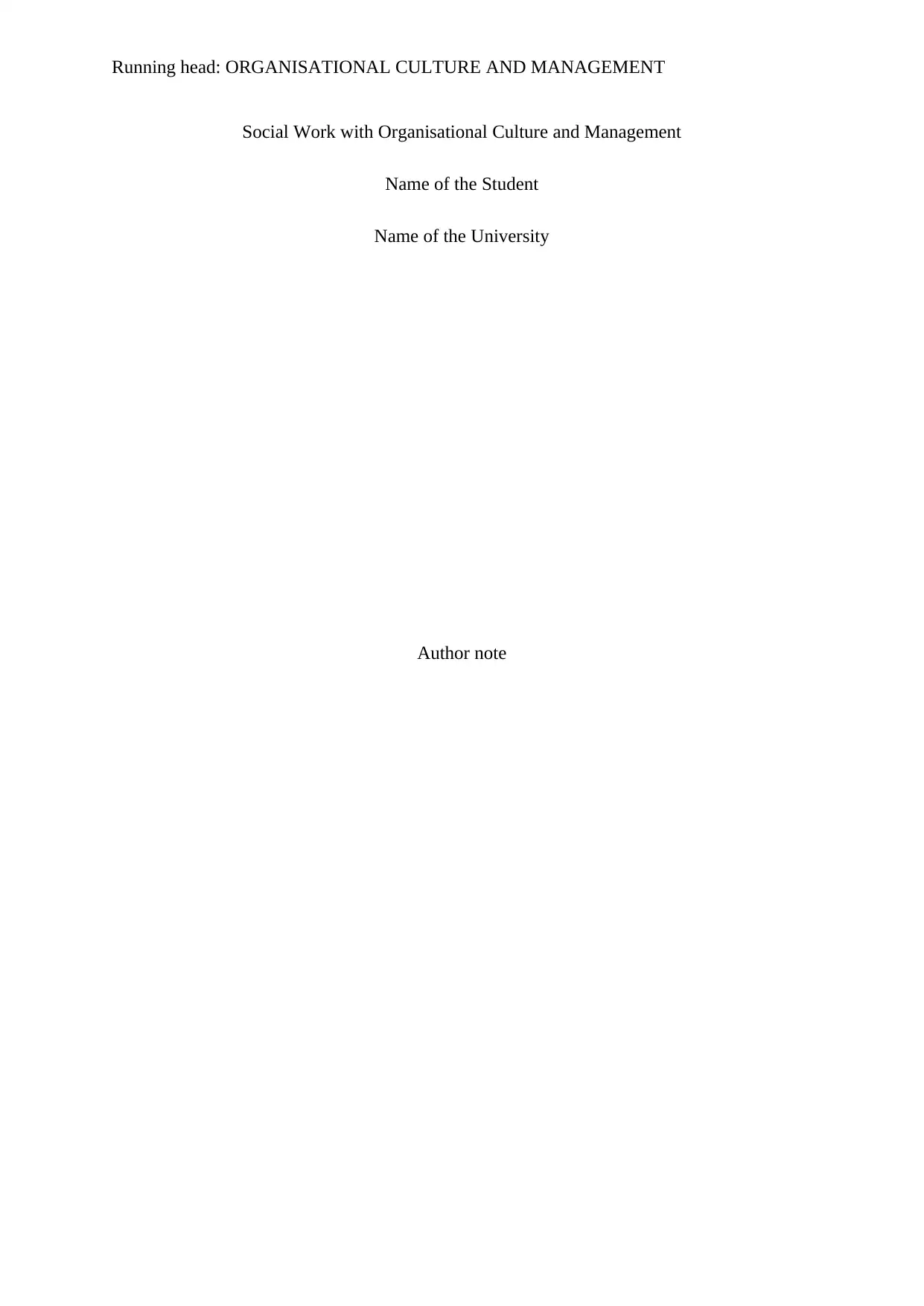
Running head: ORGANISATIONAL CULTURE AND MANAGEMENT
Social Work with Organisational Culture and Management
Name of the Student
Name of the University
Author note
Social Work with Organisational Culture and Management
Name of the Student
Name of the University
Author note
Paraphrase This Document
Need a fresh take? Get an instant paraphrase of this document with our AI Paraphraser
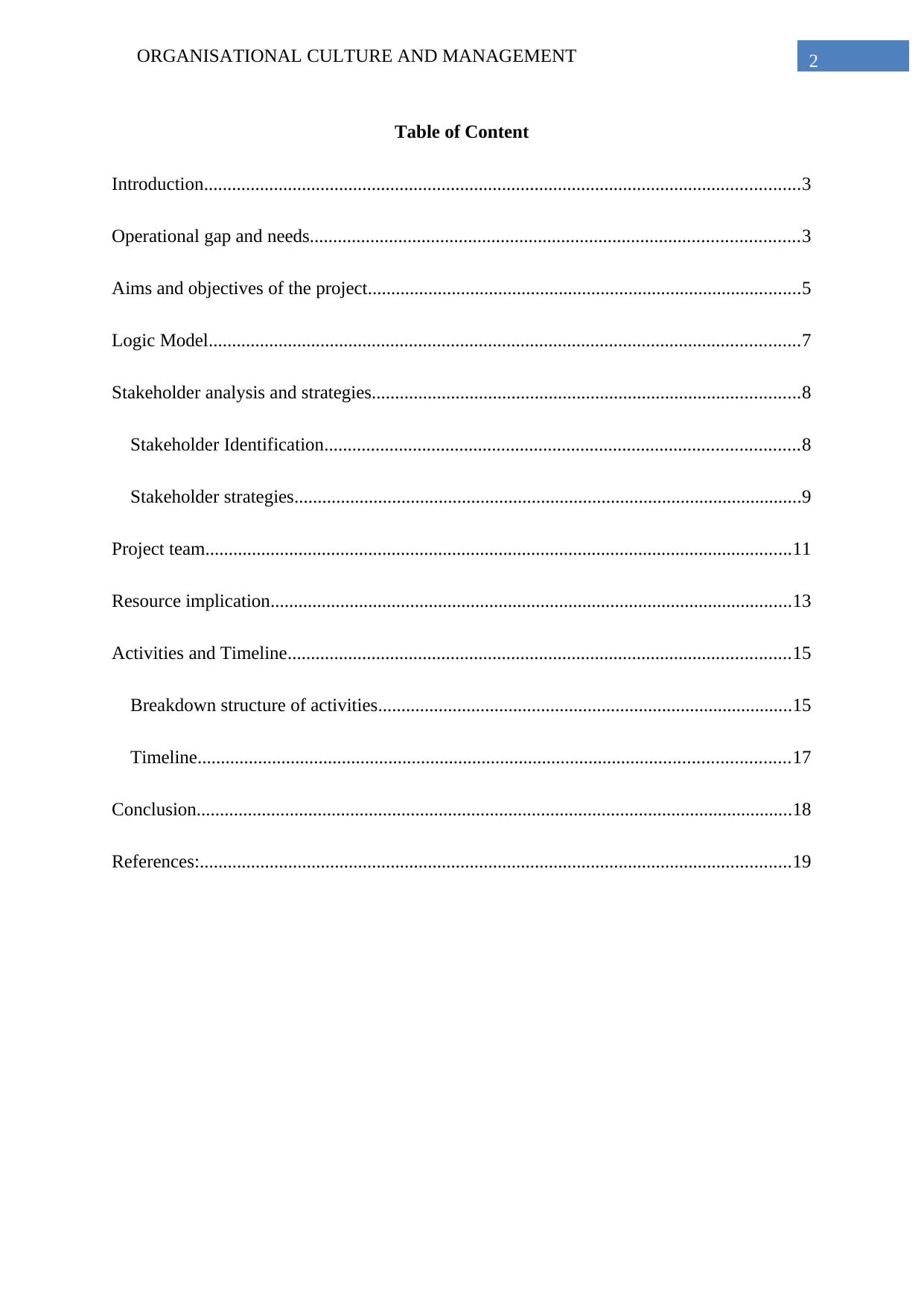
2ORGANISATIONAL CULTURE AND MANAGEMENT
Table of Content
Introduction................................................................................................................................3
Operational gap and needs.........................................................................................................3
Aims and objectives of the project.............................................................................................5
Logic Model...............................................................................................................................7
Stakeholder analysis and strategies............................................................................................8
Stakeholder Identification......................................................................................................8
Stakeholder strategies.............................................................................................................9
Project team..............................................................................................................................11
Resource implication................................................................................................................13
Activities and Timeline............................................................................................................15
Breakdown structure of activities.........................................................................................15
Timeline...............................................................................................................................17
Conclusion................................................................................................................................18
References:...............................................................................................................................19
Table of Content
Introduction................................................................................................................................3
Operational gap and needs.........................................................................................................3
Aims and objectives of the project.............................................................................................5
Logic Model...............................................................................................................................7
Stakeholder analysis and strategies............................................................................................8
Stakeholder Identification......................................................................................................8
Stakeholder strategies.............................................................................................................9
Project team..............................................................................................................................11
Resource implication................................................................................................................13
Activities and Timeline............................................................................................................15
Breakdown structure of activities.........................................................................................15
Timeline...............................................................................................................................17
Conclusion................................................................................................................................18
References:...............................................................................................................................19
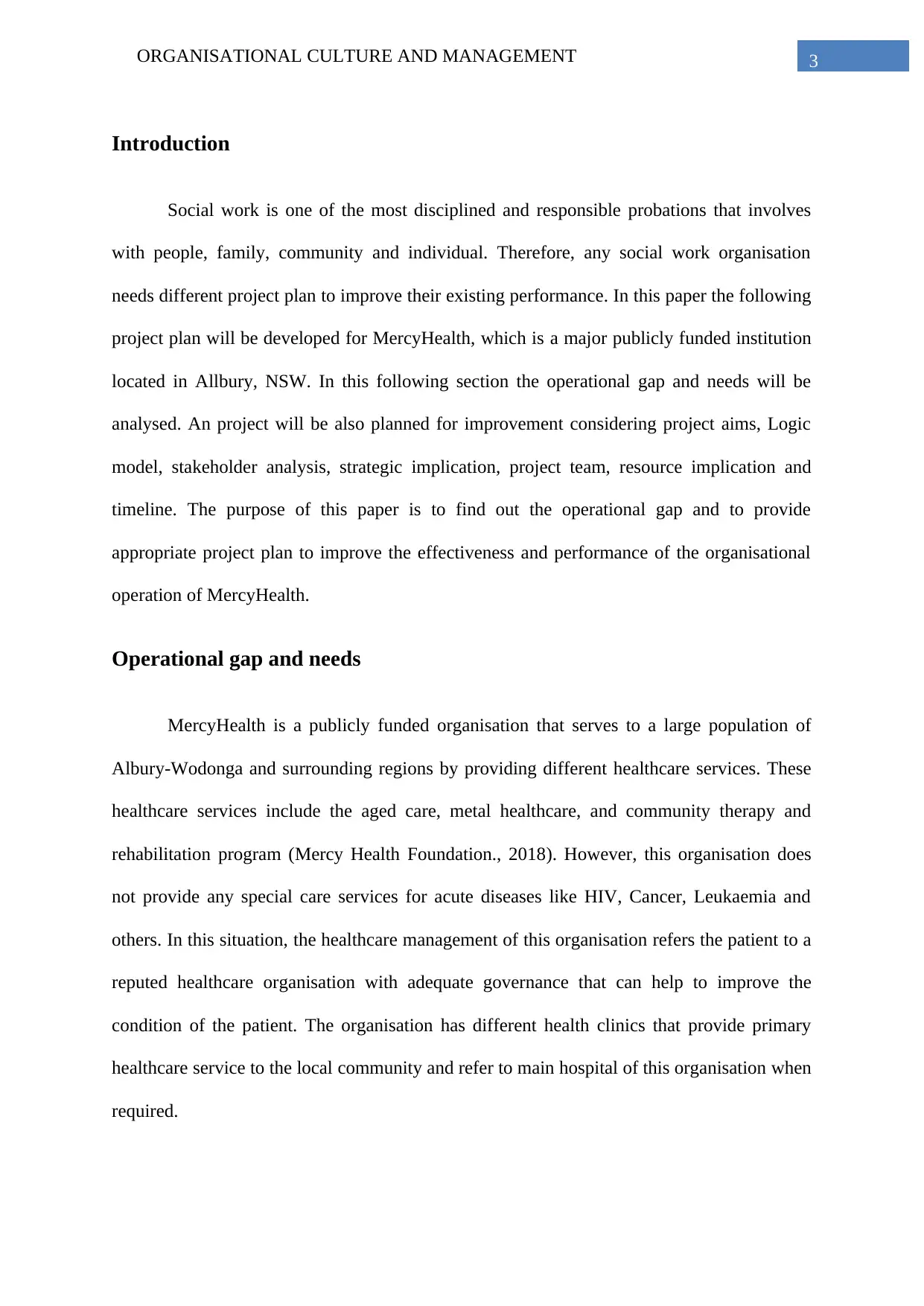
3ORGANISATIONAL CULTURE AND MANAGEMENT
Introduction
Social work is one of the most disciplined and responsible probations that involves
with people, family, community and individual. Therefore, any social work organisation
needs different project plan to improve their existing performance. In this paper the following
project plan will be developed for MercyHealth, which is a major publicly funded institution
located in Allbury, NSW. In this following section the operational gap and needs will be
analysed. An project will be also planned for improvement considering project aims, Logic
model, stakeholder analysis, strategic implication, project team, resource implication and
timeline. The purpose of this paper is to find out the operational gap and to provide
appropriate project plan to improve the effectiveness and performance of the organisational
operation of MercyHealth.
Operational gap and needs
MercyHealth is a publicly funded organisation that serves to a large population of
Albury-Wodonga and surrounding regions by providing different healthcare services. These
healthcare services include the aged care, metal healthcare, and community therapy and
rehabilitation program (Mercy Health Foundation., 2018). However, this organisation does
not provide any special care services for acute diseases like HIV, Cancer, Leukaemia and
others. In this situation, the healthcare management of this organisation refers the patient to a
reputed healthcare organisation with adequate governance that can help to improve the
condition of the patient. The organisation has different health clinics that provide primary
healthcare service to the local community and refer to main hospital of this organisation when
required.
Introduction
Social work is one of the most disciplined and responsible probations that involves
with people, family, community and individual. Therefore, any social work organisation
needs different project plan to improve their existing performance. In this paper the following
project plan will be developed for MercyHealth, which is a major publicly funded institution
located in Allbury, NSW. In this following section the operational gap and needs will be
analysed. An project will be also planned for improvement considering project aims, Logic
model, stakeholder analysis, strategic implication, project team, resource implication and
timeline. The purpose of this paper is to find out the operational gap and to provide
appropriate project plan to improve the effectiveness and performance of the organisational
operation of MercyHealth.
Operational gap and needs
MercyHealth is a publicly funded organisation that serves to a large population of
Albury-Wodonga and surrounding regions by providing different healthcare services. These
healthcare services include the aged care, metal healthcare, and community therapy and
rehabilitation program (Mercy Health Foundation., 2018). However, this organisation does
not provide any special care services for acute diseases like HIV, Cancer, Leukaemia and
others. In this situation, the healthcare management of this organisation refers the patient to a
reputed healthcare organisation with adequate governance that can help to improve the
condition of the patient. The organisation has different health clinics that provide primary
healthcare service to the local community and refer to main hospital of this organisation when
required.
⊘ This is a preview!⊘
Do you want full access?
Subscribe today to unlock all pages.

Trusted by 1+ million students worldwide
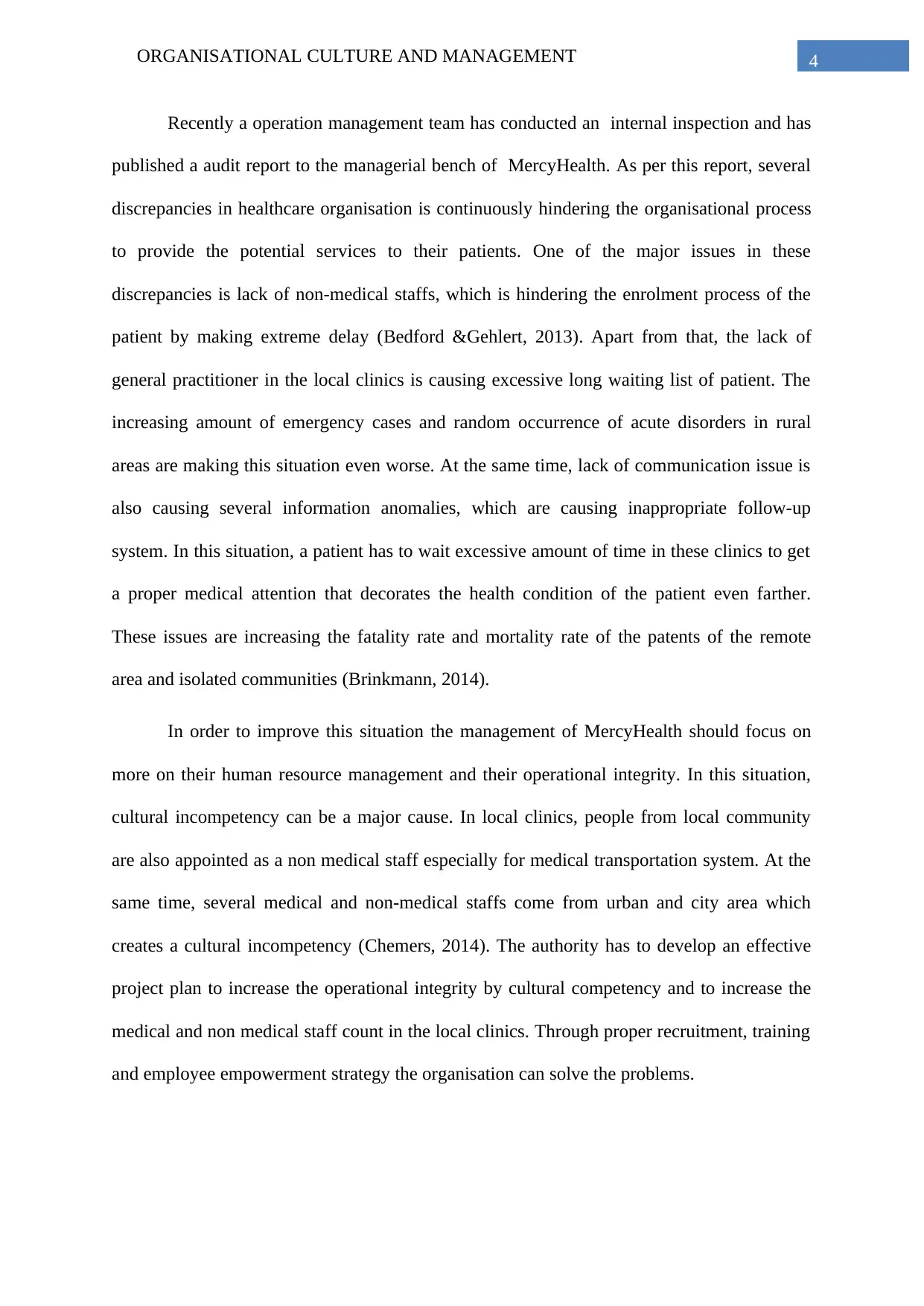
4ORGANISATIONAL CULTURE AND MANAGEMENT
Recently a operation management team has conducted an internal inspection and has
published a audit report to the managerial bench of MercyHealth. As per this report, several
discrepancies in healthcare organisation is continuously hindering the organisational process
to provide the potential services to their patients. One of the major issues in these
discrepancies is lack of non-medical staffs, which is hindering the enrolment process of the
patient by making extreme delay (Bedford &Gehlert, 2013). Apart from that, the lack of
general practitioner in the local clinics is causing excessive long waiting list of patient. The
increasing amount of emergency cases and random occurrence of acute disorders in rural
areas are making this situation even worse. At the same time, lack of communication issue is
also causing several information anomalies, which are causing inappropriate follow-up
system. In this situation, a patient has to wait excessive amount of time in these clinics to get
a proper medical attention that decorates the health condition of the patient even farther.
These issues are increasing the fatality rate and mortality rate of the patents of the remote
area and isolated communities (Brinkmann, 2014).
In order to improve this situation the management of MercyHealth should focus on
more on their human resource management and their operational integrity. In this situation,
cultural incompetency can be a major cause. In local clinics, people from local community
are also appointed as a non medical staff especially for medical transportation system. At the
same time, several medical and non-medical staffs come from urban and city area which
creates a cultural incompetency (Chemers, 2014). The authority has to develop an effective
project plan to increase the operational integrity by cultural competency and to increase the
medical and non medical staff count in the local clinics. Through proper recruitment, training
and employee empowerment strategy the organisation can solve the problems.
Recently a operation management team has conducted an internal inspection and has
published a audit report to the managerial bench of MercyHealth. As per this report, several
discrepancies in healthcare organisation is continuously hindering the organisational process
to provide the potential services to their patients. One of the major issues in these
discrepancies is lack of non-medical staffs, which is hindering the enrolment process of the
patient by making extreme delay (Bedford &Gehlert, 2013). Apart from that, the lack of
general practitioner in the local clinics is causing excessive long waiting list of patient. The
increasing amount of emergency cases and random occurrence of acute disorders in rural
areas are making this situation even worse. At the same time, lack of communication issue is
also causing several information anomalies, which are causing inappropriate follow-up
system. In this situation, a patient has to wait excessive amount of time in these clinics to get
a proper medical attention that decorates the health condition of the patient even farther.
These issues are increasing the fatality rate and mortality rate of the patents of the remote
area and isolated communities (Brinkmann, 2014).
In order to improve this situation the management of MercyHealth should focus on
more on their human resource management and their operational integrity. In this situation,
cultural incompetency can be a major cause. In local clinics, people from local community
are also appointed as a non medical staff especially for medical transportation system. At the
same time, several medical and non-medical staffs come from urban and city area which
creates a cultural incompetency (Chemers, 2014). The authority has to develop an effective
project plan to increase the operational integrity by cultural competency and to increase the
medical and non medical staff count in the local clinics. Through proper recruitment, training
and employee empowerment strategy the organisation can solve the problems.
Paraphrase This Document
Need a fresh take? Get an instant paraphrase of this document with our AI Paraphraser
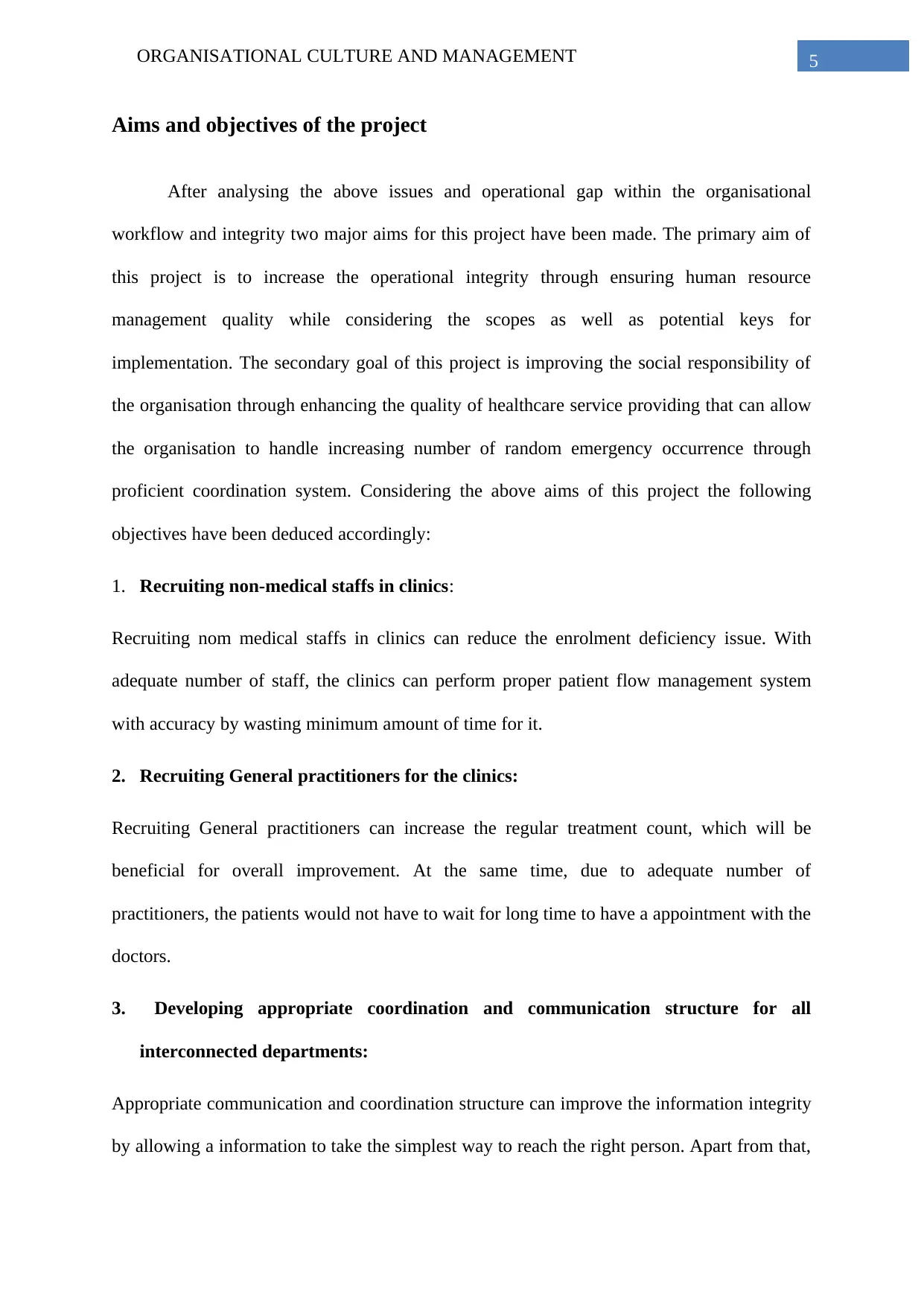
5ORGANISATIONAL CULTURE AND MANAGEMENT
Aims and objectives of the project
After analysing the above issues and operational gap within the organisational
workflow and integrity two major aims for this project have been made. The primary aim of
this project is to increase the operational integrity through ensuring human resource
management quality while considering the scopes as well as potential keys for
implementation. The secondary goal of this project is improving the social responsibility of
the organisation through enhancing the quality of healthcare service providing that can allow
the organisation to handle increasing number of random emergency occurrence through
proficient coordination system. Considering the above aims of this project the following
objectives have been deduced accordingly:
1. Recruiting non-medical staffs in clinics:
Recruiting nom medical staffs in clinics can reduce the enrolment deficiency issue. With
adequate number of staff, the clinics can perform proper patient flow management system
with accuracy by wasting minimum amount of time for it.
2. Recruiting General practitioners for the clinics:
Recruiting General practitioners can increase the regular treatment count, which will be
beneficial for overall improvement. At the same time, due to adequate number of
practitioners, the patients would not have to wait for long time to have a appointment with the
doctors.
3. Developing appropriate coordination and communication structure for all
interconnected departments:
Appropriate communication and coordination structure can improve the information integrity
by allowing a information to take the simplest way to reach the right person. Apart from that,
Aims and objectives of the project
After analysing the above issues and operational gap within the organisational
workflow and integrity two major aims for this project have been made. The primary aim of
this project is to increase the operational integrity through ensuring human resource
management quality while considering the scopes as well as potential keys for
implementation. The secondary goal of this project is improving the social responsibility of
the organisation through enhancing the quality of healthcare service providing that can allow
the organisation to handle increasing number of random emergency occurrence through
proficient coordination system. Considering the above aims of this project the following
objectives have been deduced accordingly:
1. Recruiting non-medical staffs in clinics:
Recruiting nom medical staffs in clinics can reduce the enrolment deficiency issue. With
adequate number of staff, the clinics can perform proper patient flow management system
with accuracy by wasting minimum amount of time for it.
2. Recruiting General practitioners for the clinics:
Recruiting General practitioners can increase the regular treatment count, which will be
beneficial for overall improvement. At the same time, due to adequate number of
practitioners, the patients would not have to wait for long time to have a appointment with the
doctors.
3. Developing appropriate coordination and communication structure for all
interconnected departments:
Appropriate communication and coordination structure can improve the information integrity
by allowing a information to take the simplest way to reach the right person. Apart from that,
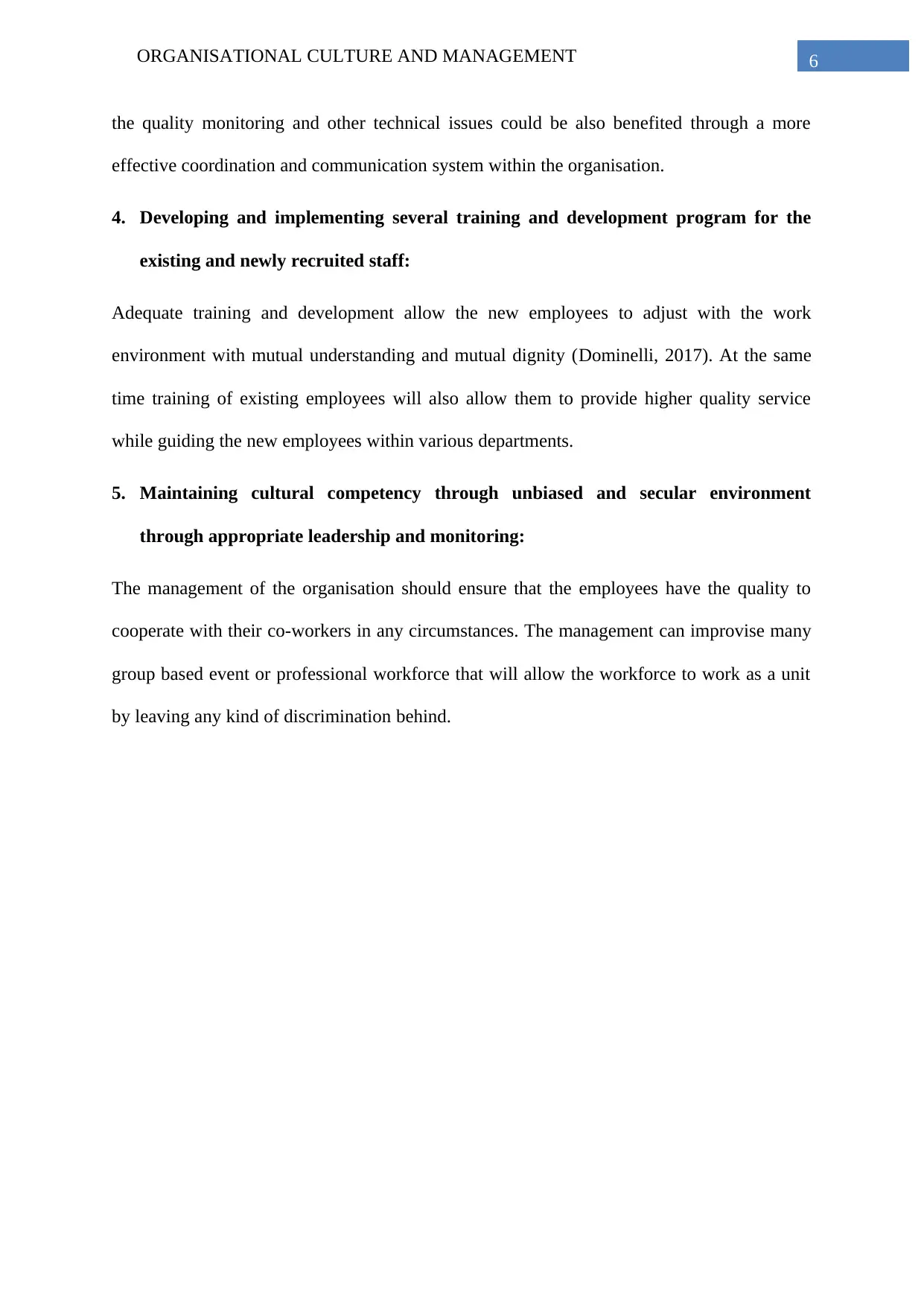
6ORGANISATIONAL CULTURE AND MANAGEMENT
the quality monitoring and other technical issues could be also benefited through a more
effective coordination and communication system within the organisation.
4. Developing and implementing several training and development program for the
existing and newly recruited staff:
Adequate training and development allow the new employees to adjust with the work
environment with mutual understanding and mutual dignity (Dominelli, 2017). At the same
time training of existing employees will also allow them to provide higher quality service
while guiding the new employees within various departments.
5. Maintaining cultural competency through unbiased and secular environment
through appropriate leadership and monitoring:
The management of the organisation should ensure that the employees have the quality to
cooperate with their co-workers in any circumstances. The management can improvise many
group based event or professional workforce that will allow the workforce to work as a unit
by leaving any kind of discrimination behind.
the quality monitoring and other technical issues could be also benefited through a more
effective coordination and communication system within the organisation.
4. Developing and implementing several training and development program for the
existing and newly recruited staff:
Adequate training and development allow the new employees to adjust with the work
environment with mutual understanding and mutual dignity (Dominelli, 2017). At the same
time training of existing employees will also allow them to provide higher quality service
while guiding the new employees within various departments.
5. Maintaining cultural competency through unbiased and secular environment
through appropriate leadership and monitoring:
The management of the organisation should ensure that the employees have the quality to
cooperate with their co-workers in any circumstances. The management can improvise many
group based event or professional workforce that will allow the workforce to work as a unit
by leaving any kind of discrimination behind.
⊘ This is a preview!⊘
Do you want full access?
Subscribe today to unlock all pages.

Trusted by 1+ million students worldwide
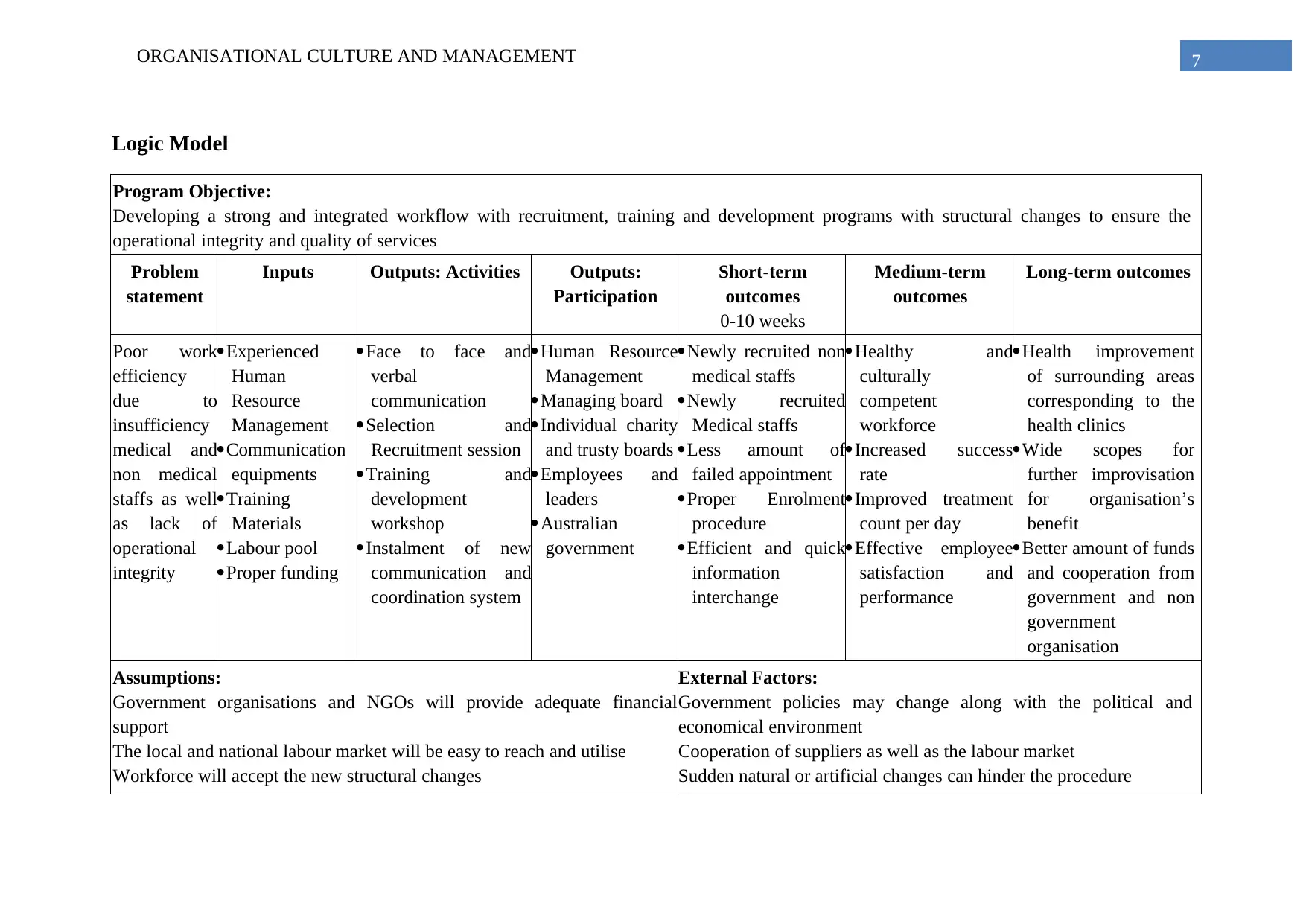
7ORGANISATIONAL CULTURE AND MANAGEMENT
Logic Model
Program Objective:
Developing a strong and integrated workflow with recruitment, training and development programs with structural changes to ensure the
operational integrity and quality of services
Problem
statement
Inputs Outputs: Activities Outputs:
Participation
Short-term
outcomes
0-10 weeks
Medium-term
outcomes
Long-term outcomes
Poor work
efficiency
due to
insufficiency
medical and
non medical
staffs as well
as lack of
operational
integrity
Experienced
Human
Resource
Management
Communication
equipments
Training
Materials
Labour pool
Proper funding
Face to face and
verbal
communication
Selection and
Recruitment session
Training and
development
workshop
Instalment of new
communication and
coordination system
Human Resource
Management
Managing board
Individual charity
and trusty boards
Employees and
leaders
Australian
government
Newly recruited non
medical staffs
Newly recruited
Medical staffs
Less amount of
failed appointment
Proper Enrolment
procedure
Efficient and quick
information
interchange
Healthy and
culturally
competent
workforce
Increased success
rate
Improved treatment
count per day
Effective employee
satisfaction and
performance
Health improvement
of surrounding areas
corresponding to the
health clinics
Wide scopes for
further improvisation
for organisation’s
benefit
Better amount of funds
and cooperation from
government and non
government
organisation
Assumptions:
Government organisations and NGOs will provide adequate financial
support
The local and national labour market will be easy to reach and utilise
Workforce will accept the new structural changes
External Factors:
Government policies may change along with the political and
economical environment
Cooperation of suppliers as well as the labour market
Sudden natural or artificial changes can hinder the procedure
Logic Model
Program Objective:
Developing a strong and integrated workflow with recruitment, training and development programs with structural changes to ensure the
operational integrity and quality of services
Problem
statement
Inputs Outputs: Activities Outputs:
Participation
Short-term
outcomes
0-10 weeks
Medium-term
outcomes
Long-term outcomes
Poor work
efficiency
due to
insufficiency
medical and
non medical
staffs as well
as lack of
operational
integrity
Experienced
Human
Resource
Management
Communication
equipments
Training
Materials
Labour pool
Proper funding
Face to face and
verbal
communication
Selection and
Recruitment session
Training and
development
workshop
Instalment of new
communication and
coordination system
Human Resource
Management
Managing board
Individual charity
and trusty boards
Employees and
leaders
Australian
government
Newly recruited non
medical staffs
Newly recruited
Medical staffs
Less amount of
failed appointment
Proper Enrolment
procedure
Efficient and quick
information
interchange
Healthy and
culturally
competent
workforce
Increased success
rate
Improved treatment
count per day
Effective employee
satisfaction and
performance
Health improvement
of surrounding areas
corresponding to the
health clinics
Wide scopes for
further improvisation
for organisation’s
benefit
Better amount of funds
and cooperation from
government and non
government
organisation
Assumptions:
Government organisations and NGOs will provide adequate financial
support
The local and national labour market will be easy to reach and utilise
Workforce will accept the new structural changes
External Factors:
Government policies may change along with the political and
economical environment
Cooperation of suppliers as well as the labour market
Sudden natural or artificial changes can hinder the procedure
Paraphrase This Document
Need a fresh take? Get an instant paraphrase of this document with our AI Paraphraser
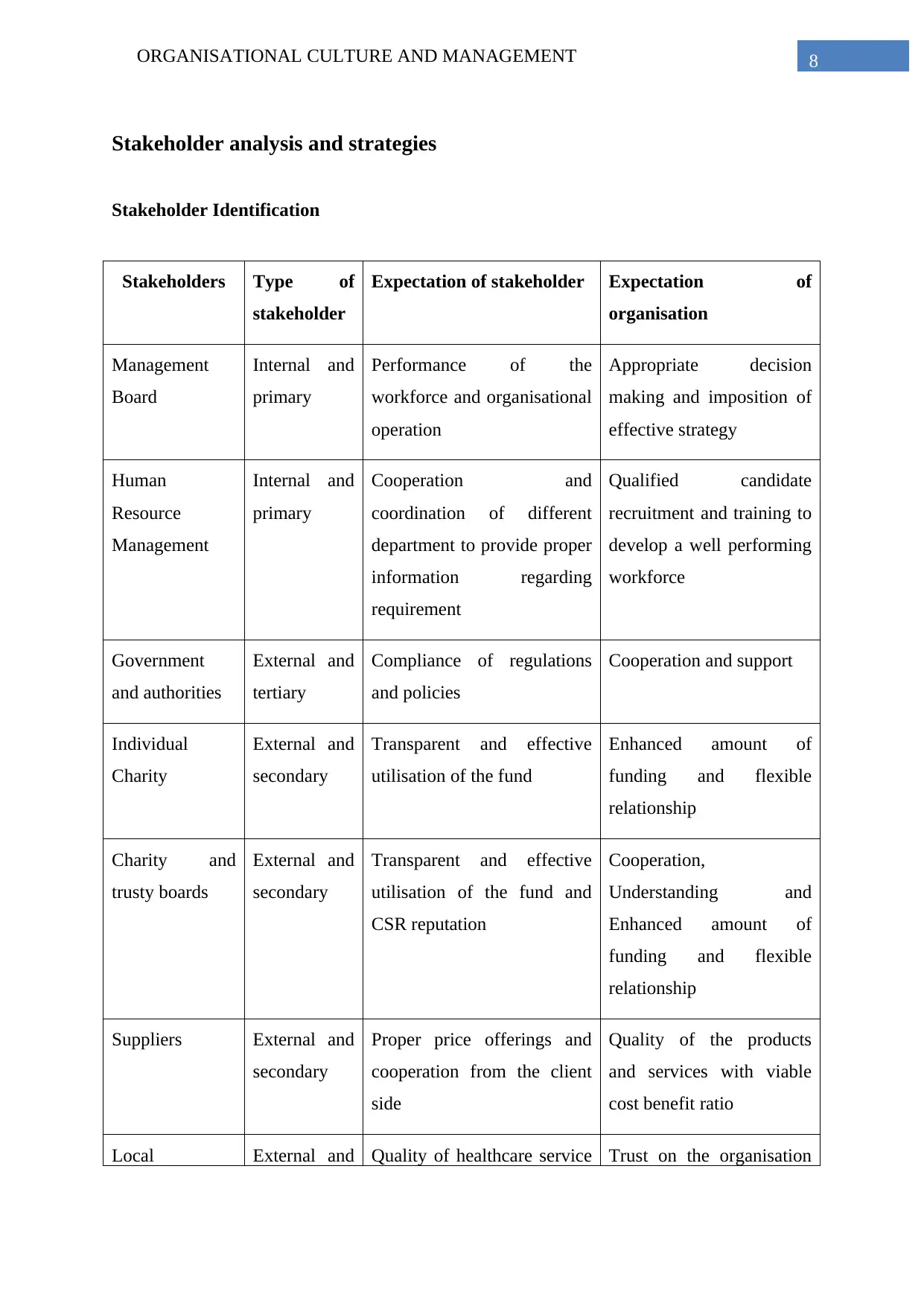
8ORGANISATIONAL CULTURE AND MANAGEMENT
Stakeholder analysis and strategies
Stakeholder Identification
Stakeholders Type of
stakeholder
Expectation of stakeholder Expectation of
organisation
Management
Board
Internal and
primary
Performance of the
workforce and organisational
operation
Appropriate decision
making and imposition of
effective strategy
Human
Resource
Management
Internal and
primary
Cooperation and
coordination of different
department to provide proper
information regarding
requirement
Qualified candidate
recruitment and training to
develop a well performing
workforce
Government
and authorities
External and
tertiary
Compliance of regulations
and policies
Cooperation and support
Individual
Charity
External and
secondary
Transparent and effective
utilisation of the fund
Enhanced amount of
funding and flexible
relationship
Charity and
trusty boards
External and
secondary
Transparent and effective
utilisation of the fund and
CSR reputation
Cooperation,
Understanding and
Enhanced amount of
funding and flexible
relationship
Suppliers External and
secondary
Proper price offerings and
cooperation from the client
side
Quality of the products
and services with viable
cost benefit ratio
Local External and Quality of healthcare service Trust on the organisation
Stakeholder analysis and strategies
Stakeholder Identification
Stakeholders Type of
stakeholder
Expectation of stakeholder Expectation of
organisation
Management
Board
Internal and
primary
Performance of the
workforce and organisational
operation
Appropriate decision
making and imposition of
effective strategy
Human
Resource
Management
Internal and
primary
Cooperation and
coordination of different
department to provide proper
information regarding
requirement
Qualified candidate
recruitment and training to
develop a well performing
workforce
Government
and authorities
External and
tertiary
Compliance of regulations
and policies
Cooperation and support
Individual
Charity
External and
secondary
Transparent and effective
utilisation of the fund
Enhanced amount of
funding and flexible
relationship
Charity and
trusty boards
External and
secondary
Transparent and effective
utilisation of the fund and
CSR reputation
Cooperation,
Understanding and
Enhanced amount of
funding and flexible
relationship
Suppliers External and
secondary
Proper price offerings and
cooperation from the client
side
Quality of the products
and services with viable
cost benefit ratio
Local External and Quality of healthcare service Trust on the organisation
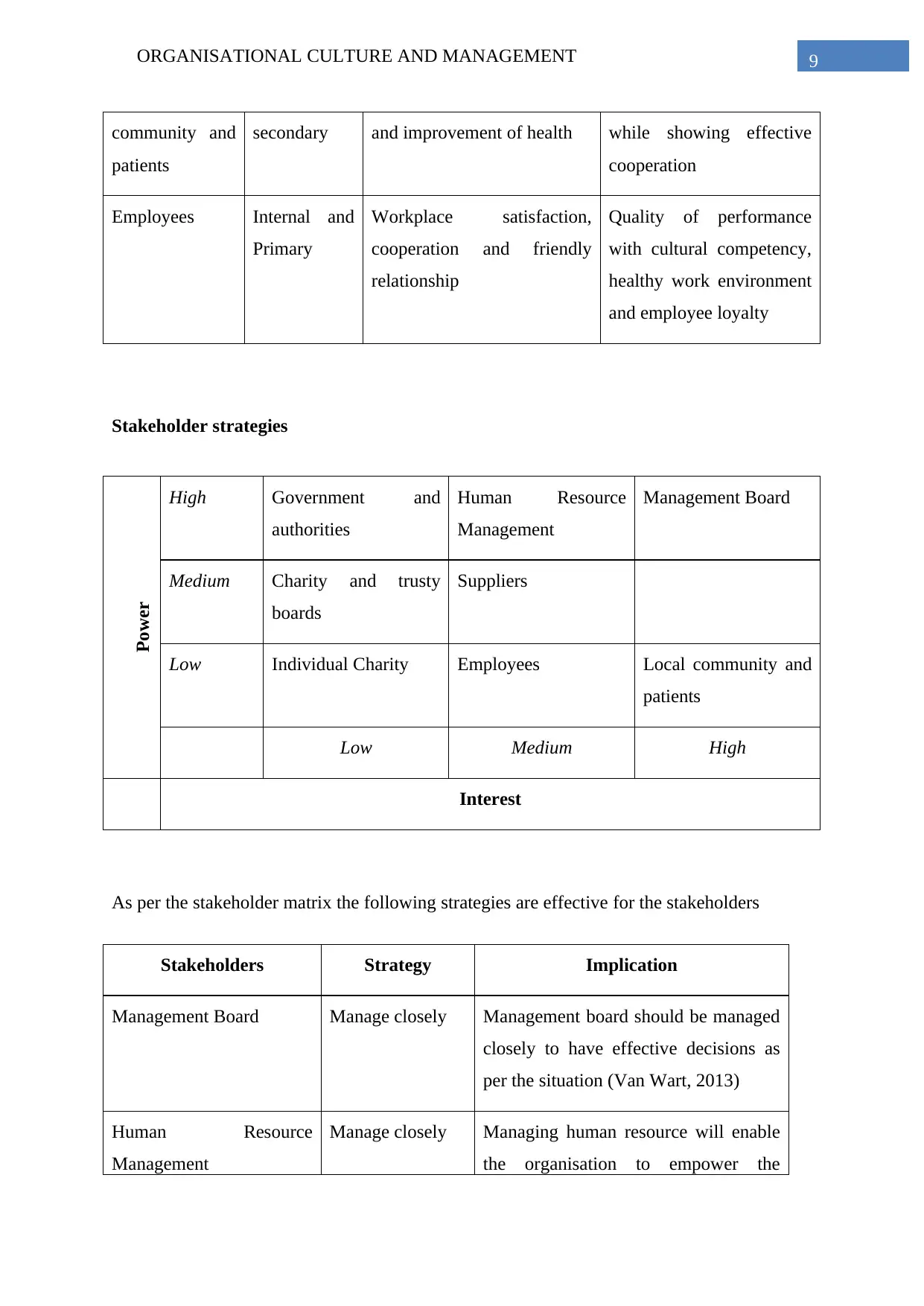
9ORGANISATIONAL CULTURE AND MANAGEMENT
community and
patients
secondary and improvement of health while showing effective
cooperation
Employees Internal and
Primary
Workplace satisfaction,
cooperation and friendly
relationship
Quality of performance
with cultural competency,
healthy work environment
and employee loyalty
Stakeholder strategies
Power
High Government and
authorities
Human Resource
Management
Management Board
Medium Charity and trusty
boards
Suppliers
Low Individual Charity Employees Local community and
patients
Low Medium High
Interest
As per the stakeholder matrix the following strategies are effective for the stakeholders
Stakeholders Strategy Implication
Management Board Manage closely Management board should be managed
closely to have effective decisions as
per the situation (Van Wart, 2013)
Human Resource
Management
Manage closely Managing human resource will enable
the organisation to empower the
community and
patients
secondary and improvement of health while showing effective
cooperation
Employees Internal and
Primary
Workplace satisfaction,
cooperation and friendly
relationship
Quality of performance
with cultural competency,
healthy work environment
and employee loyalty
Stakeholder strategies
Power
High Government and
authorities
Human Resource
Management
Management Board
Medium Charity and trusty
boards
Suppliers
Low Individual Charity Employees Local community and
patients
Low Medium High
Interest
As per the stakeholder matrix the following strategies are effective for the stakeholders
Stakeholders Strategy Implication
Management Board Manage closely Management board should be managed
closely to have effective decisions as
per the situation (Van Wart, 2013)
Human Resource
Management
Manage closely Managing human resource will enable
the organisation to empower the
⊘ This is a preview!⊘
Do you want full access?
Subscribe today to unlock all pages.

Trusted by 1+ million students worldwide
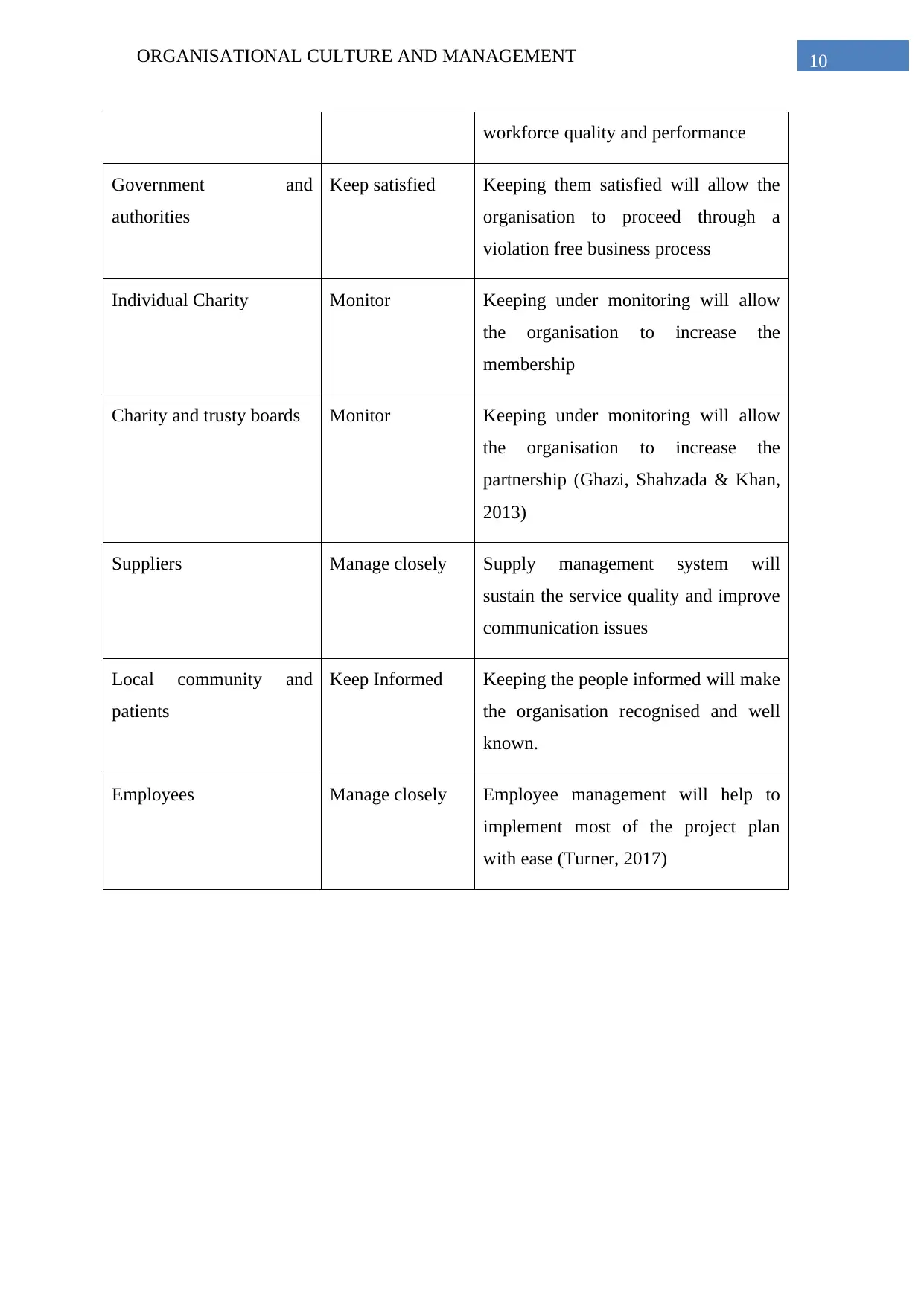
10ORGANISATIONAL CULTURE AND MANAGEMENT
workforce quality and performance
Government and
authorities
Keep satisfied Keeping them satisfied will allow the
organisation to proceed through a
violation free business process
Individual Charity Monitor Keeping under monitoring will allow
the organisation to increase the
membership
Charity and trusty boards Monitor Keeping under monitoring will allow
the organisation to increase the
partnership (Ghazi, Shahzada & Khan,
2013)
Suppliers Manage closely Supply management system will
sustain the service quality and improve
communication issues
Local community and
patients
Keep Informed Keeping the people informed will make
the organisation recognised and well
known.
Employees Manage closely Employee management will help to
implement most of the project plan
with ease (Turner, 2017)
workforce quality and performance
Government and
authorities
Keep satisfied Keeping them satisfied will allow the
organisation to proceed through a
violation free business process
Individual Charity Monitor Keeping under monitoring will allow
the organisation to increase the
membership
Charity and trusty boards Monitor Keeping under monitoring will allow
the organisation to increase the
partnership (Ghazi, Shahzada & Khan,
2013)
Suppliers Manage closely Supply management system will
sustain the service quality and improve
communication issues
Local community and
patients
Keep Informed Keeping the people informed will make
the organisation recognised and well
known.
Employees Manage closely Employee management will help to
implement most of the project plan
with ease (Turner, 2017)
Paraphrase This Document
Need a fresh take? Get an instant paraphrase of this document with our AI Paraphraser
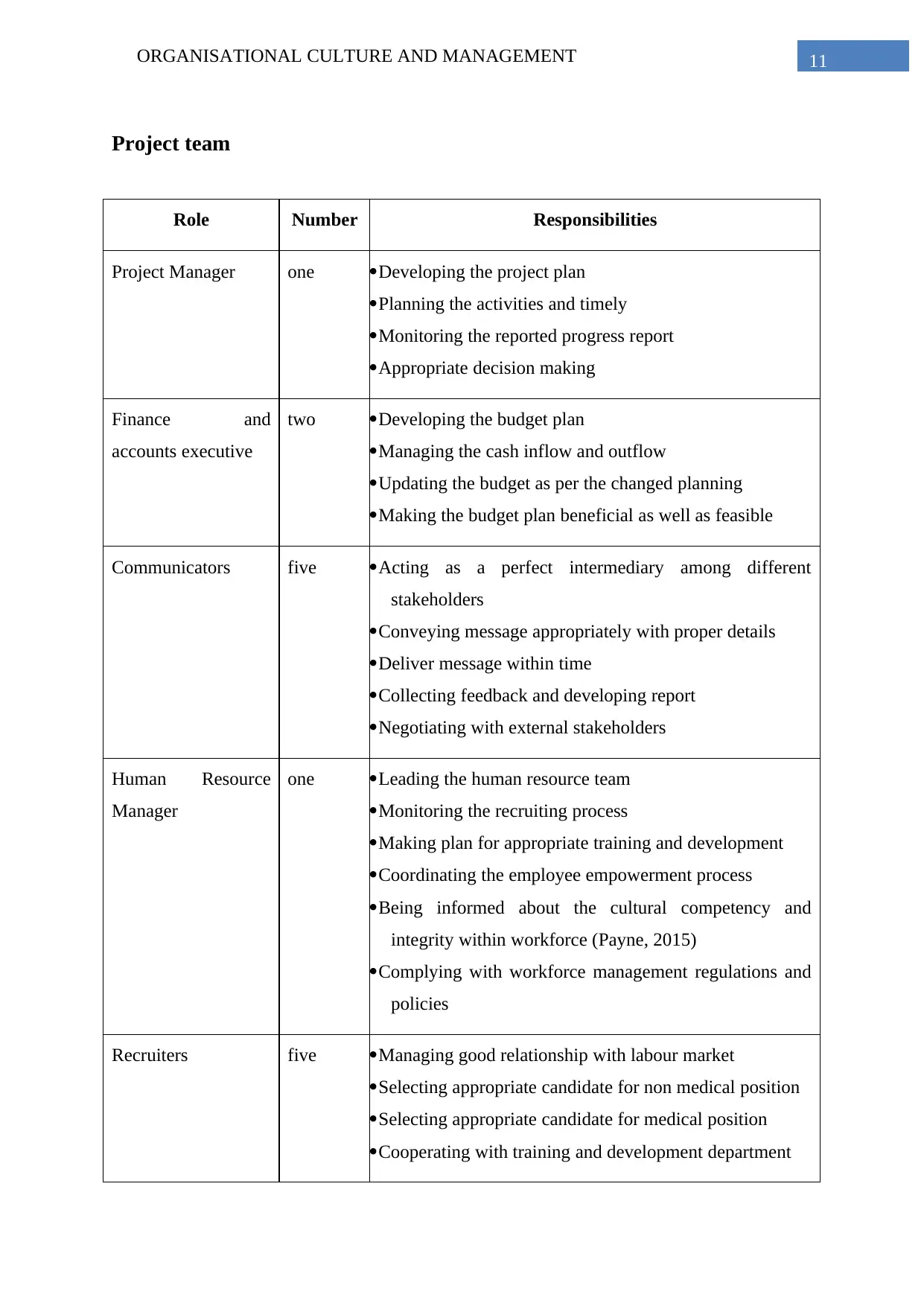
11ORGANISATIONAL CULTURE AND MANAGEMENT
Project team
Role Number Responsibilities
Project Manager one Developing the project plan
Planning the activities and timely
Monitoring the reported progress report
Appropriate decision making
Finance and
accounts executive
two Developing the budget plan
Managing the cash inflow and outflow
Updating the budget as per the changed planning
Making the budget plan beneficial as well as feasible
Communicators five Acting as a perfect intermediary among different
stakeholders
Conveying message appropriately with proper details
Deliver message within time
Collecting feedback and developing report
Negotiating with external stakeholders
Human Resource
Manager
one Leading the human resource team
Monitoring the recruiting process
Making plan for appropriate training and development
Coordinating the employee empowerment process
Being informed about the cultural competency and
integrity within workforce (Payne, 2015)
Complying with workforce management regulations and
policies
Recruiters five Managing good relationship with labour market
Selecting appropriate candidate for non medical position
Selecting appropriate candidate for medical position
Cooperating with training and development department
Project team
Role Number Responsibilities
Project Manager one Developing the project plan
Planning the activities and timely
Monitoring the reported progress report
Appropriate decision making
Finance and
accounts executive
two Developing the budget plan
Managing the cash inflow and outflow
Updating the budget as per the changed planning
Making the budget plan beneficial as well as feasible
Communicators five Acting as a perfect intermediary among different
stakeholders
Conveying message appropriately with proper details
Deliver message within time
Collecting feedback and developing report
Negotiating with external stakeholders
Human Resource
Manager
one Leading the human resource team
Monitoring the recruiting process
Making plan for appropriate training and development
Coordinating the employee empowerment process
Being informed about the cultural competency and
integrity within workforce (Payne, 2015)
Complying with workforce management regulations and
policies
Recruiters five Managing good relationship with labour market
Selecting appropriate candidate for non medical position
Selecting appropriate candidate for medical position
Cooperating with training and development department
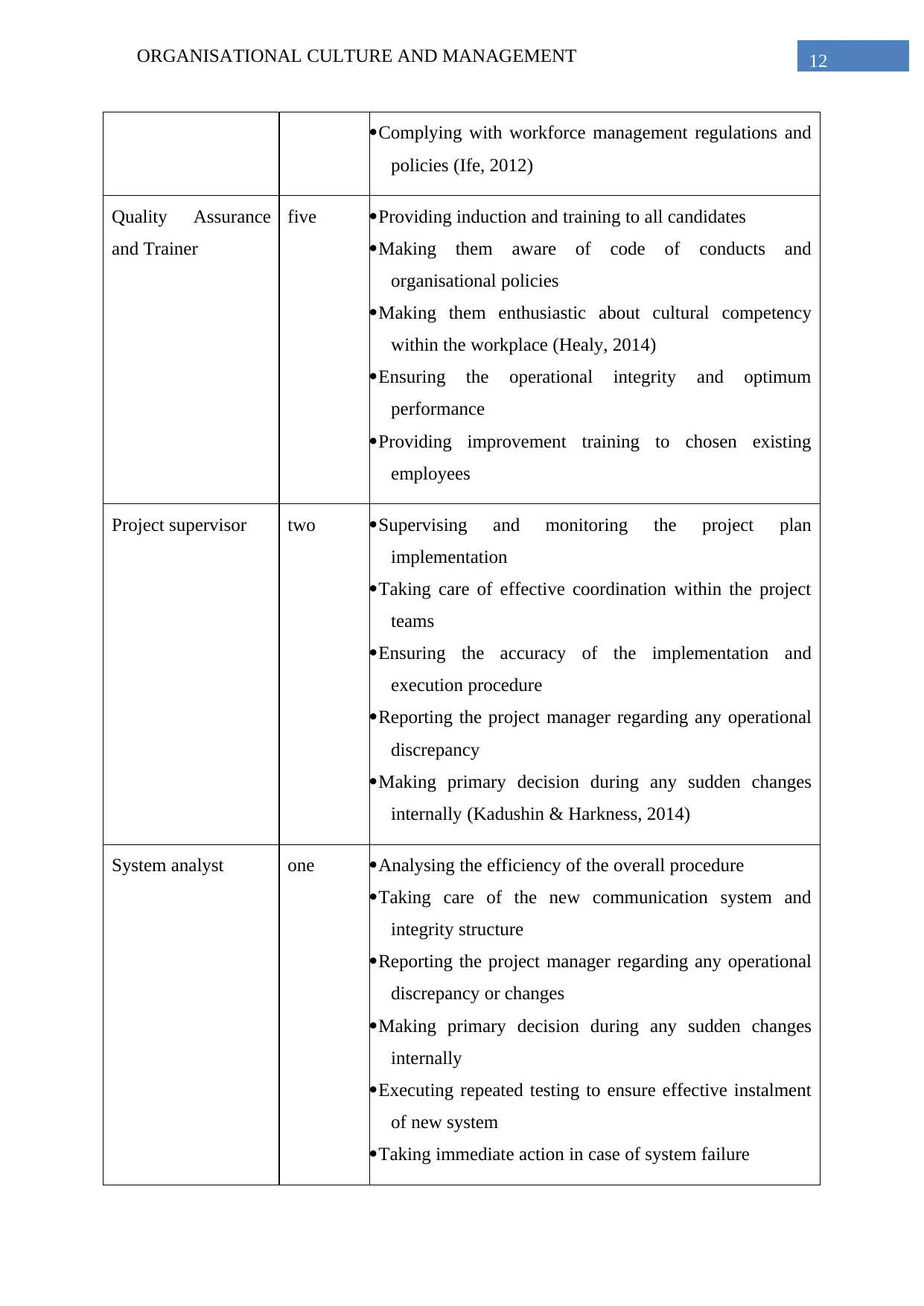
12ORGANISATIONAL CULTURE AND MANAGEMENT
Complying with workforce management regulations and
policies (Ife, 2012)
Quality Assurance
and Trainer
five Providing induction and training to all candidates
Making them aware of code of conducts and
organisational policies
Making them enthusiastic about cultural competency
within the workplace (Healy, 2014)
Ensuring the operational integrity and optimum
performance
Providing improvement training to chosen existing
employees
Project supervisor two Supervising and monitoring the project plan
implementation
Taking care of effective coordination within the project
teams
Ensuring the accuracy of the implementation and
execution procedure
Reporting the project manager regarding any operational
discrepancy
Making primary decision during any sudden changes
internally (Kadushin & Harkness, 2014)
System analyst one Analysing the efficiency of the overall procedure
Taking care of the new communication system and
integrity structure
Reporting the project manager regarding any operational
discrepancy or changes
Making primary decision during any sudden changes
internally
Executing repeated testing to ensure effective instalment
of new system
Taking immediate action in case of system failure
Complying with workforce management regulations and
policies (Ife, 2012)
Quality Assurance
and Trainer
five Providing induction and training to all candidates
Making them aware of code of conducts and
organisational policies
Making them enthusiastic about cultural competency
within the workplace (Healy, 2014)
Ensuring the operational integrity and optimum
performance
Providing improvement training to chosen existing
employees
Project supervisor two Supervising and monitoring the project plan
implementation
Taking care of effective coordination within the project
teams
Ensuring the accuracy of the implementation and
execution procedure
Reporting the project manager regarding any operational
discrepancy
Making primary decision during any sudden changes
internally (Kadushin & Harkness, 2014)
System analyst one Analysing the efficiency of the overall procedure
Taking care of the new communication system and
integrity structure
Reporting the project manager regarding any operational
discrepancy or changes
Making primary decision during any sudden changes
internally
Executing repeated testing to ensure effective instalment
of new system
Taking immediate action in case of system failure
⊘ This is a preview!⊘
Do you want full access?
Subscribe today to unlock all pages.

Trusted by 1+ million students worldwide
1 out of 20
Related Documents
Your All-in-One AI-Powered Toolkit for Academic Success.
+13062052269
info@desklib.com
Available 24*7 on WhatsApp / Email
![[object Object]](/_next/static/media/star-bottom.7253800d.svg)
Unlock your academic potential
Copyright © 2020–2025 A2Z Services. All Rights Reserved. Developed and managed by ZUCOL.




